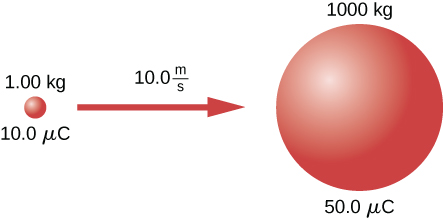| << Chapter < Page | Chapter >> Page > |
Now consider another system of two point charges. One has a mass of 1000 kg and a charge of 50.0 µC, and is initially stationary. The other has a mass of 1.00 kg, a charge of 10.0 µC, and is initially traveling directly at the first point charge at 10.0 m/s from very far away. What will be the closest approach of these two objects to each other?

Note that the internal energy of this two-charge system will not change, due to an absence of external forces acting on the system. Initially, the internal energy is equal to the kinetic energy of the smaller charge, and the potential energy is effectively zero due to the enormous distance between the two objects. Conservation of energy tells us that the internal energy of this system will not change. Hence the distance of closest approach will be when the internal energy is equal to the potential energy between the two charges, and there is no kinetic energy in this system.
The initial kinetic energy may be calculated as 50.0 J. Applying Equations (19.38) and (19.2), we find a distance of 9.00 cm. After this, the mutual repulsion will send the lighter object off to infinity again. Note that we did not include potential energy due to gravity, as the masses concerned are so small compared to the charges that the result will never come close to showing up in significant digits. Furthermore, the first object is much more massive than the second. As a result, any motion induced in it will also be too small to show up in the significant digits.
An electron is placed in an electric field of 12.0 N/C to the right. What is the resulting force on the electron?
(a)
A positively charged object in a certain electric field is currently being pushed west by the resulting force. How will the force change if the charge grows? What if it becomes negative?
A −5.0 C charge is being forced south by a 60 N force. What are the magnitude and direction of the local electric field?
(b)
A charged object has a net force of 100 N east acting on it due to an electric field of 50 N/C pointing north. How is this possible? If not, why not?
How many electrons have to be moved by a car battery containing 7.20×10 5 J at 12 V to reduce the energy by 1%?
(c)
Most of the electricity in the power grid is generated by powerful turbines spinning around. Why don’t these turbines slow down from the work they do moving electrons?
A typical AAA battery can move 2000 C of charge at 1.5 V. How long will this run a 50 mW LED?
(a)
Find an example car (or other vehicle) battery, and compute how many of the AAA batteries in the previous problem it would take to equal the energy stored in it. Which is more compact?

Notification Switch
Would you like to follow the 'College physics for ap® courses' conversation and receive update notifications?